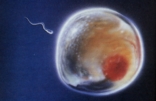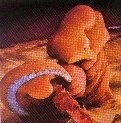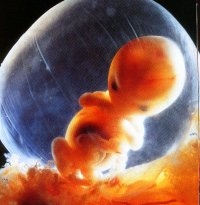|
|
|

|
||||
|
The unborn child |
Years ago, while giving an anesthetic for a ruptured tubal pregnancy (at two months) I was handed what I believed to be the smallest human being ever seen. The embryo sac was intact and transparent. Within the sac was a tiny human male, swimming extremely vigorously in the amnionic fluid, while attached to the wall by the umbilical cord. The tiny human was perfectly developed, with long, tapering fingers, feet and toes. It was almost transparent as regards to the skin, and the delicate arteries and veins were prominent to the ends of the fingers. The baby was extremely alive and did not look at all like the photos and drawings of 'embryos' which I have seen. When the sac was opened, the tiny human immediately lost its life and took on what is accepted as the appearance of an embryo at this stage, blunt extremities, etc. |
|||
| ||||

|
2 weeks
- Fertilization: the sperm and egg join in the fallopian tube to form a unique human being. Forty-six chromosomes combine, which pre-determine all of a person's physical
characteristics.
The picture on the right is a fertilized egg, only thirty hours after conception. Magnified here, it is no larger than the head of a pin. Still rapidly dividing, the developing embryo, called a zygote at this stage, floats down from the fallopian tube and towards the uterus. |
|
||
|
|
||||

|
4 weeks - The embryo produces hormones which stop the mother's menstrual cycle.
|
|||
|
7 weeks - Facial features are visible, including a mouth and tongue. The eyes have a retina and lens. The major muscle system is developed, and the unborn child practices moving. The child has its own blood type, distinct from the mother's. These blood cells are produced by the liver now instead of the yolk sac. |
|
|||

|
8 weeks - The unborn child, called a fetus at this stage, is about half an inch long. The tiny person is protected by the amnionic sac, filled with fluid. Inside, the child swims and moves gracefully. The arms and legs have lengthened, and fingers can be seen. The toes will develop in the next few days. Brain waves can be measured. |
|||
|
10 weeks - The heart is almost completely developed and very much resembles that of a newborn baby. An opening the atrium of the heart and the presence of a bypass valve divert much of the blood away from the lungs, as the child's blood is oxygenated through the placenta. Twenty tiny baby teeth are forming in the gums.
| ||||